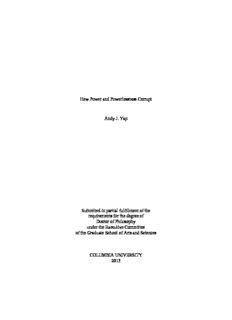Table Of ContentHow Power and Powerlessness Corrupt
Andy J. Yap
Submitted in partial fulfillment of the
requirements for the degree of
Doctor of Philosophy
under the Executive Committee
of the Graduate School of Arts and Sciences
COLUMBIA UNIVERSITY
2013
© 2013
Andy J. Yap
All rights reserved
ABSTRACT
How Power and Powerlessness Corrupt
Andy J. Yap
This dissertation examines how and when, both powerfulness and powerlessness, can
each lead to corrupt behavior. The first half of this dissertation (Chapters 2 to 5) focuses on the
link between power and corrupt behavior. Building on previous work that expansive posture
induces a state of power, four studies tested whether expansive posture incidentally imposed by
our environment lead to increases in dishonest behavior. Chapters 2 to 4 present three
experiments, which found that powerful individuals were more likely to steal money, cheat on a
test, and commit traffic violations in a driving simulation. Results suggested that participants’
self-reported sense of power mediated the link between postural expansiveness and dishonesty.
In an observational field study, Chapter 5 revealed that automobiles with more expansive
driver’s seats were more likely to be illegally parked on New York City streets.
The second part of the dissertation examines if powerlessness can lead to corrupt
behavior. Chapters 6 to 10 present a new theoretical model that comprehensively integrates
theories on power and regulatory focus. This model reveals that both powerfulness and
powerlessness can each lead to corrupt behavior, but through different routes. Three experiments
in Chapters 7 to 9 found that prevention-powerlessness and promotion-powerfulness produce
more corrupt behavior than promotion-powerlessness and prevention-powerfulness, as evident in
individuals’ tendency to exploit others, aggression, and dishonest behavior. I also found evidence
for the affective manifestations that accompany these effects. Indeed, a meta-analysis on the
data suggests that prevention-powerlessness and promotion-powerfulness significantly produced
more corrupt behavior than prevention-powerfulness and promotion-powerlessness. These
findings have important theoretical implications for power and regulatory focus, and explicate
how powerlessness can lead to taking action and even corruption.
TABLE OF CONTENTS
Page
LIST OF TABLES iv
LIST OF FIGURES v
ACKNOWLEDGEMENTS vi
CHAPTER ONE
INTRODUCTION 1
The Ergonomics of Dishonesty 2
Powerful Postures 4
Power and Dishonest Behavior 5
The Focus of the Current Research on The Ergonomics of Dishonesty 6
CHAPTER TWO
FIELD EXPERIMENT: STEALING BY OMMISSION
Method 8
Results & Discussion 8
CHAPTER THREE
LABORATORY EXPERIMENT: CHEATING ON A TEST
Methods 10
Results & Discussion 11
CHAPTER FOUR
LABORATORY EXPERIMENT: HIT AND RUN IN A DRIVING SIMULATION
Methods 12
Results & Discussion 13
CHAPTER FIVE
OBSERVATIONAL FIELD STUDY: PARKING VIOLATIONS
Methods 14
Results & Discussion 15
i
General Discussion On The Ergonomics of Dishonesty 16
CHAPTER SIX
THE INTEGRATIVE EFFECTS OF POWER AND REGULATORY FOCUS 19
Regulatory Focus Theory 20
Theoretical and Empirical Implications 23
Overview Of Studies 25
CHAPTER SEVEN
EXPERIMENT: EXPLOITING OTHERS
Methods 26
Results & Discussion 27
CHAPTER EIGHT
EXPERIMENT: AGGRESSION
Methods 29
Results & Discussion 30
CHAPTER NINE
EXPERIMENT: CHEATING ON A TEST
Methods 31
Results 32
Meta-analysis 32
Discussion of the Integrative Effects of Regulatory Focus and Power 33
CHAPTER TEN
GENERAL DISCUSSION AND CONCLUSIONS 34
Theoretical Contributions 34
Practical Implications 38
Conclusion 41
ii
FOOTNOTES 42
REFERENCES 44
TABLES 56
FIGURES 57
iii
LIST OF TABLES
Page
Table 1:
Table 1: Mean Level of Corrupt Behavior and Effect Sizes of Contrast 56
iv
LIST OF FIGURES
Page
Figure 1: Poses employed in Field Experiment: Stealing by Omission 57
Figure 2: How the money was presented in Field Experiment: Stealing by Omission 58
Figure 3: Desk-space configurations for Laboratory Experiment: Cheating on a Test 59
Figure 4: Driver’s seat configurations for Laboratory Experiment: Driving Simulation 60
Figure 5: Laboratory Experiment: Driving Simulation: Mediation Analysis 61
Figure 6: Observational Field Study: Vehicle Size Computation 62
Figure 7: Exploiting others 63
Figure 8: Aggression 64
Figure 9: Cheating on a Test 65
Figure 10: Negative Affective States 66
v
ACKNOWLEDGEMENTS
I am eternally indebted to a number of people who have contributed significantly to the
completion of this dissertation. I have the most amazing graduate advisors and mentors that
anyone can hope for. They are brilliant, distinguished scholars in their fields, and most
importantly, exceptionally devoted to me and my training.
I would like to thank Dana Carney for her generous support, mentorship and friendship.
Dana provided the type of support and nurturance that a fledgling academic can only dream
about. She taught me how to be brave and diligent when my research moves into uncharted
territory, and figure out which questions are important to pursue in my research.
I especially want to thank Tory Higgins for inspiring and supporting me. Tory has an
amazing ability to cultivate a sense of excitement and positivity, and an appreciation for big-
picture ideas in science. He is a model of the kind of academic I would someday like to be, and I
count myself a true honor to be his student.
I am very grateful to Adam Galinsky for his incomparable mentorship, patience, and keen
insight. Adam is the busiest and most available person at the same time. I thank him for always
making time to listen, offer advice, and inspire me with his enthusiasm to do good science.
Daniel Ames, shared with me his brilliance, diligence and grit to tackle difficult but
important questions. Daniel taught me how to effectively communicate my work with clarity and
finesse. Above all, Daniel is affable and brilliant, the perfect combination that makes him a great
mentor.
Joel Brockner taught me how to talk through problems collaboratively and keep
recursively question the answers to problems until a clear understanding materializes. Joel was
never afraid to challenge me and push my thinking while offering constant intellectual support.
vi
Description:Yip, Geoff Ho, Sunny Kim, Kenneth Tai, Martin Schweinsberg, Zhang Shu, Abbie . Coats, & Smith LeBeau, 2005; Tiedens & Fragale, 2003; Weisfeld .. of power was significant (point estimate = .72, bias-corrected bootstrap 95%

